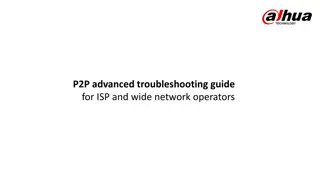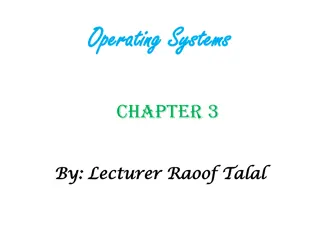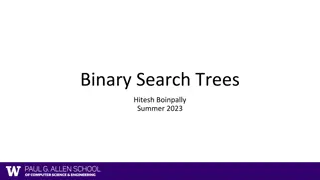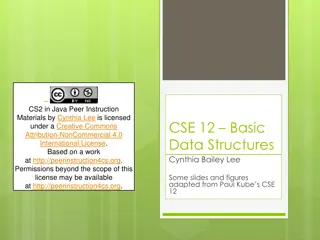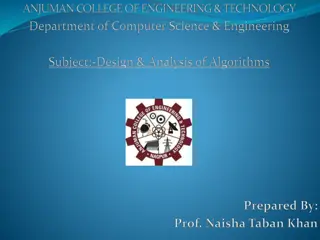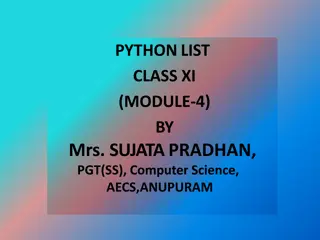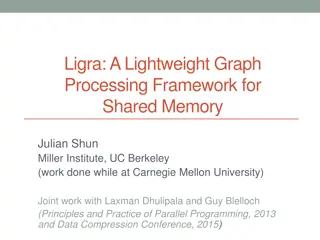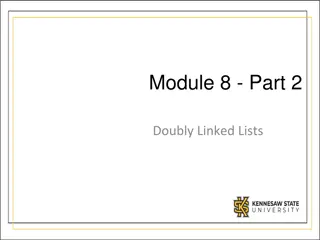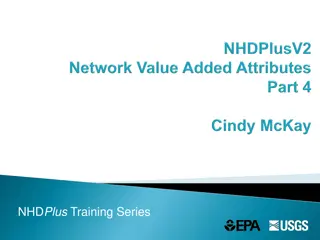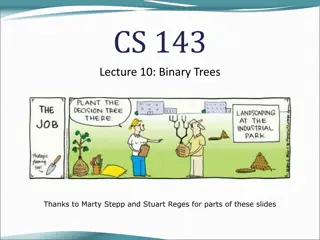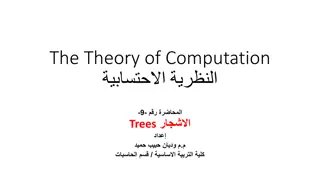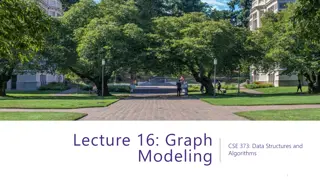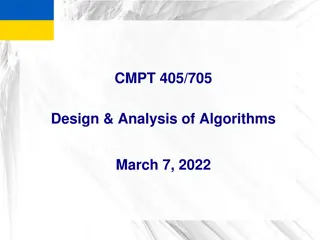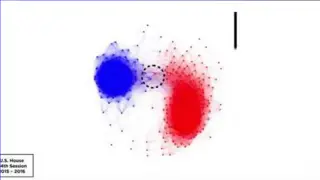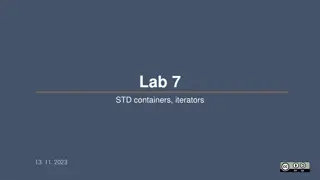Apache MINA: High-performance Network Applications Framework
Apache MINA is a robust framework for building high-performance network applications. With features like non-blocking I/O, event-driven architecture, and enhanced scalability, MINA provides a reliable platform for developing multipurpose infrastructure and networked applications. Its strengths lie i
3 views • 13 slides
Modeling and Generation of Realistic Network Activity Using Non-Negative Matrix Factorization
The GHOST project focuses on the challenges of modeling, analyzing, and generating patterns of network activity. By utilizing Non-Negative Matrix Factorization (NMF), realistic network activity patterns can be created and injected into live wireless networks. Understanding and predicting user behavi
4 views • 28 slides
Automated Anomaly Detection Tool for Network Performance Optimization
Anomaly Detection Tool (ADT) aims to automate the detection of network degradation in a mobile communications network, reducing the time and effort required significantly. By utilizing statistical and machine learning models, ADT can generate anomaly reports efficiently across a large circle network
8 views • 7 slides
Revolutionizing Network Management with Intent-Based Networking
Explore the concept and benefits of Intent-Based Networking (IBN) in simplifying network configuration and enhancing efficiency. Learn how IBN automates network operations, aligns with business objectives, improves security, and ensures scalability and reliability. Discover the potential of IBN tool
0 views • 14 slides
Network Compression Techniques: Overview and Practical Issues
Various network compression techniques such as network pruning, knowledge distillation, and parameter quantization are discussed in this content. The importance of pruning redundant weights and neurons in over-parameterized networks is highlighted. Practical issues like weight pruning and neuron pru
0 views • 37 slides
Advanced Troubleshooting Guide for P2P Connectivity in ISP and Wide Networks
This troubleshooting guide is tailored for operators, network experts, and engineers dealing with Dahua P2P NAT traversal protocol issues. It covers different types of NAT, including Full Cone NAT, Restricted Cone NAT, Port Restricted Cone NAT, and Symmetric NAT, providing insights and solutions for
0 views • 17 slides
Network Slicing with OAI 5G CN Workshop Overview
Overview of Network Slicing with OAI 5G CN workshop focusing on the crucial role of network slicing in realizing the service-oriented 5G vision. This workshop covers topics like multiple logical networks creation on shared infrastructure, different types of network slices, preparation and instantiat
1 views • 6 slides
Network Design Challenges and Solutions in Business Data Communications
Issues in designing a Local Area Network (LAN) include needs analysis, technological design, and cost assessment. The traditional approach involves structured systems analysis, but faces challenges due to rapidly changing technology and increasing network traffic. The Building Blocks Approach recomm
1 views • 20 slides
Exploring Trees Data Structures Using C - Second Edition
Learn about trees data structures in the context of programming using the C language. This comprehensive guide covers topics such as types of trees, tree creation, traversal, basic terminologies, and different tree structures like binary trees and binary search trees. Dive into the world of trees da
2 views • 54 slides
Understanding Strings in Python Programming
Strings in Python are sequences of characters with various operations like initialization, accessing, traversal, slicing, and mutability. Learn about basic concepts, such as string initialization using quotes, accessing individual characters, determining string length, traversing strings, slicing su
0 views • 20 slides
Understanding 5G RAN Network Slicing and Architecture
Explore the intricate world of 5G Radio Access Network (RAN) and Network Slicing, delving into concepts such as SO Service Orchestrator, SDN-C Service Design, and Core Network Elements. Discover the significance of managing and designing mobile slice services, including eMBB, Massive IoT, and Missio
0 views • 26 slides
Understanding Snort: An Open-Source Network Intrusion Detection System
Snort is an open-source Network Intrusion Detection System (NIDS) developed by Cisco, capable of analyzing network packets to identify suspicious activities. It can function as a packet sniffer, packet logger, or a full-fledged intrusion prevention system. By monitoring and matching network activity
0 views • 23 slides
Understanding Directory Structures in Operating Systems
Directory structures play a crucial role in operating systems, organizing files, and supporting essential operations like file search, creation, deletion, listing, and traversal. This content explores single-level and two-level directory structures, addressing their benefits and limitations in manag
2 views • 23 slides
Data Flows and Network Challenges in Particle Physics Infrastructure
This overview delves into the data flows and network challenges faced in particle physics infrastructure, focusing on the JUNO project. It discusses the process of data reception, storage, and replication across various data centers, highlighting the bidirectional nature of data flows. Additionally,
0 views • 24 slides
Progress of Network Architecture Work in FG IMT-2020
In the Network Architecture Group led by Namseok Ko, significant progress has been made in defining the IMT-2020 architecture. The work has involved gap analysis, draft recommendations, and setting framework and requirements. Phase 1 focused on identifying 19 architectural gaps, such as demands for
1 views • 11 slides
Understanding Interconnection Networks Topology
Exploring the topology of interconnection networks helps determine the arrangement of channels and nodes, impacting network cost, performance, latency, energy consumption, and complexity of implementation. Abstract metrics such as degree, hop count, and network diameter play crucial roles in evaluat
1 views • 56 slides
Transportation Network Modeling and Analysis with C.Coupled SE Platform
This content outlines the features and functionalities of the C.Coupled SE Platform (CSET Platform) developed by the Connetics Transportation Group. It covers aspects such as interface design, inputs merging, purposes, platform development using Cube, TAZs merging, and network attributes. The platfo
0 views • 11 slides
Understanding Binary Search Trees and Tree Traversal Methods
Explore the world of binary search trees with a focus on defining trees, modifying them, and different ways to print their contents. Delve into the concept of tree traversal methods such as pre-order, in-order, and post-order. Additionally, discover insights into searching algorithms for arrays of n
0 views • 14 slides
Binary Trees and Heap Implementation in Java
Explore the concepts of binary trees, heap implementation, and traversal techniques in Java through engaging peer instruction materials by Cynthia Lee. Learn about heap uniqueness, in-place heapsort, and generic binary trees. Test your knowledge with reading quizzes and analyze heap outcomes based o
0 views • 27 slides
Comprehensive Course Overview on Algorithm Analysis and Design
Explore a detailed syllabus covering mathematical foundations, complexity calculations, asymptotic analysis, dynamic programming, traversal techniques, and more. Dive into key concepts like recursion, divide and conquer, greedy algorithms, backtracking, and approximation algorithms. Gain insights in
1 views • 11 slides
Meridian: An SDN Platform for Cloud Network Services
Meridian is an SDN platform developed by Mohammad Banikazemi, David Olshefski, Anees Shaikh, John Tracey, and GuohuiWang at IBM T. J. Watson Research Center. The platform focuses on providing cloud network services efficiently. It encompasses an architecture that enables faster and more convenient n
0 views • 21 slides
Exploring Python Lists in Class XI Module-4 by Mrs. Sujata Pradhan
Exploring list structures, characteristics, and operations in Python. Covering topics such as mutability, basic list operations, indexing, slicing, concatenation, repetition, traversal, updation, and comparison. Detailed explanations on list methods like append, extend, insert, index, sort, count, r
0 views • 12 slides
Ligra: A Lightweight Graph Processing Framework for Shared Memory
Ligra is a lightweight graph processing framework developed by Julian Shun during his time at the Miller Institute, UC Berkeley. This framework, created in collaboration with Laxman Dhulipala and Guy Blelloch, is designed for shared memory systems to efficiently analyze large graphs. Key features in
0 views • 21 slides
Understanding Graph Data Structures and Algorithms by Ali Akbar Mohammadi
This content delves into the foundational concepts of graph data structures, covering topics such as graph traversal, transitive closure, minimum spanning trees, and more. Ali Akbar Mohammadi provides insight into the world of graphs, emphasizing the importance of vertices, edges, and the relationsh
0 views • 19 slides
Understanding Doubly Linked Lists in Data Structures
Doubly linked lists contain nodes with both forward and backward links, allowing traversal in both directions. The nodes can be inserted or deleted at the beginning, middle, or end, requiring updating of links accordingly. Additionally, a recursive method can be used to manipulate data in each node,
0 views • 17 slides
Understanding NHDPlus Training Series: PlusFlow Table and Tool Navigator
This content delves into understanding the format and content of the NHDPlus Training Series, specifically focusing on the PlusFlow Table and NHDPlusV2 Flow Table Navigator Tool. It explains the purpose of the tool, how it enables network traversal, and the key components of the PlusFlow Table. Addi
0 views • 21 slides
Understanding Graph Modeling and DFS Applications
Explore the world of graph modeling and DFS applications through lectures on graph vocabulary, edge classification in directed graphs, and the use of DFS to find cycles. Discover the significance of tree edges, back edges, forward edges, and cross edges in graph traversal. Learn how DFS can be utili
0 views • 32 slides
Understanding Network Analysis: Whole Networks vs. Ego Networks
Explore the differences between Whole Networks and Ego Networks in social network analysis. Whole Networks provide comprehensive information about all nodes and links, enabling the computation of network-level statistics. On the other hand, Ego Networks focus on a sample of nodes, limiting the abili
0 views • 31 slides
Understanding Binary Trees in Computer Science
Binary trees are a fundamental data structure in computer science with various applications. This content covers the basics of binary trees, including terminology, recursive definitions, node structures, and implementations in computer science. It touches on important concepts such as recursion, tre
0 views • 28 slides
Understanding Tree Data Structures in Computation
Explore the theory of computation trees, tree properties, and terminology including nodes, root, leaves, siblings, ancestors, descendants, and more. Learn about subtree representation, tree traversal methods, and the concept of binary trees in computing.
0 views • 10 slides
Graph Modeling in Data Structures and Algorithms
Exploring graph modeling in CSE 373, this lecture covers topics such as using BFS for finding shortest paths, limitations of BFS on weighted graphs, and the introduction of Dijkstra's algorithm for weighted graphs. It emphasizes the importance of considering edge weights in determining traversal ord
0 views • 29 slides
Understanding B-Trees: A Comprehensive Guide
B-Trees are a standard data structure for key-value stores, ensuring efficient CRUD operations and range queries. They store records structured in a balanced tree format, ideal for fast data retrieval. This guide explores different variants and examples of B-Trees, explaining their functionalities a
0 views • 73 slides
Network Function Virtualization (NFV) Overview
Network Function Virtualization (NFV) focuses on virtualizing network functions to improve efficiency and reduce costs in network infrastructure. The lecture discusses key readings, devices that compose a network, specialization of devices, benefits of one-device-does-anything approach, and the goal
0 views • 21 slides
Enhancing Network Stability with Network Monitoring Systems
Network monitoring is crucial for efficient management and proactive issue detection in a network environment. Factors influencing an effective network system include choosing the best OEM, SLA agreements, and selecting a reliable System Integrator. Reactive monitoring can lead to financial losses a
0 views • 12 slides
Dynamic Programming for Finding Paths of Length k in Graphs
Today's plan involves exploring dynamic programming techniques for finding paths of length k in graphs. The focus will be on solving the rainbow-k-path problem and utilizing DP algorithms to achieve efficient solutions. By constructing tables and utilizing key observations, we aim to find simple pat
0 views • 15 slides
Depth-First Search Exploration Techniques
Depth-First Search (DFS) is a graph traversal algorithm that explores all edges leaving a vertex before backtracking. It continues until all reachable vertices are discovered. This process involves classifying edges as tree, back, forward, or cross edges based on the relationship between vertices. D
0 views • 22 slides
Understanding Depth-First Search in Graph Algorithms
Delve into the world of graph algorithms and explore Depth-First Search (DFS) in both undirected and directed graphs. Learn about tree edges, back edges, forward edges, and cross edges, along with the terminology associated with DFS trees. Discover how to detect back edges and perform a depth-first
2 views • 22 slides
Understanding STD Containers and Iterators in C++ Programming
In C++ programming, STD containers and iterators play a crucial role in managing data structures and traversal methods efficiently. By utilizing these tools effectively, programmers can enhance the performance and reliability of their code. This involves working with various container types, such as
0 views • 33 slides
Accelerating Systemic Change Network Inaugural Workshop Summary
The Accelerating Systemic Change Network held its inaugural workshop at Howard Hughes Medical Institute in July 2016 to address the lack of coordination in improving higher education. With a vision to become a professional hub for change researchers in STEM education, the network aims to enhance ind
0 views • 5 slides
University Network Section Overview July 2015 - March 2016
The presentation covers the network team structure, team members, objectives, goals, report outline, network statistics, accomplishments, and future plans of the university network section from July 2015 to March 2016. It highlights efforts to provide stable internet and intranet services, restructu
0 views • 16 slides





